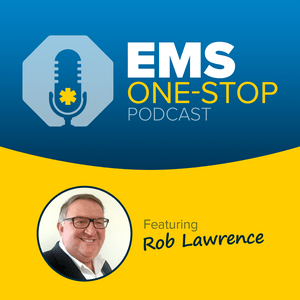Inside the EMS Compact: How REPLICA transforms disaster response, licensing & leadership
In this episode of the EMS One-Stop podcast, host Rob Lawrence kicks off a special series spotlighting national EMS associations, beginning with a deep dive into the EMS Personnel Licensure Interstate CompAct (REPLICA). His guest, Donnie Woodyard Jr., executive director, Interstate Commission for EMS Personnel Practice, brings decades of EMS experience and leadership to the table to demystify what the EMS Compact is, how it operates, and why it matters to the profession today. From improving workforce mobility to protecting public safety during disasters, Woodyard Jr. provides clarity on this critical multi-state agreement.
The conversation covers everything from how EMS Compact came to be, to the significance of national registry standards, disaster response logistics, interstate licensure, and even leadership lessons from Woodyard Jr.’s latest book project, “Leadership in action: The Wisdom and stories of EMS innovators”. Whether you're a field provider or policymaker, this episode is a must-listen for understanding how collaborative legislation can shape the future of EMS.
In the episode, Woodyard Jr. candidly addresses the ongoing debate in North Carolina over transitioning from a state-only EMS certification exam to exclusive use of the National Registry. Woodyard Jr., while respectful of North Carolina’s long-standing EMS tradition, emphasizes the importance of national consistency. He acknowledged that the proposed legislation needed amendments, particularly around grandfathering existing providers, but stood firm in his belief that a single, legally defensible national standard is essential for provider mobility and professional integrity. Drawing on real-world examples, Woodyard Jr. described how providers are often caught off guard when relocating — only to discover their credentials aren't accepted elsewhere. “Maintaining a state-only exam is harmful to individuals,” he said, calling for unified testing standards that support workforce movement and strengthens the profession nationwide.
Memorable quotes from Donnie Woodyard Jr
“Every EMT and paramedic in the United States should go through a fingerprint background check. You know, babysitters have to do it. Teachers have to do it. EMS personnel absolutely should do it.”
“Maintaining a state-only exam is harmful to individuals. It limits their mobility.”
“When you waive that requirement for licensure, you actually are removing essential elements of public protection and accountability.”
Timeline
00:21 – Rob introduces the series on national EMS associations and welcomes Donnie Woodyard, Jr.
01:55 – Woodyard, Jr.shares his EMS journey from volunteer in Virginia to international disaster medicine and state leadership
03:41 – What is the EMS Compact and how does it work?
06:38 – Challenges of multistate EMS licensing pre-Compact
08:00 – Explaining the driver’s license analogy and compact accountability
11:17 – EMAC vs. EMS Compact for disaster response and liability concerns
15:31 – National Registry and grandfathering provisions
17:30 – Arkansas joins as the 25th compact state
18:56 – Model legislation and how states join the compact
21:22 – What REPLICA stands for and its legislative origin
22:20 – What California (and other non-compact states) should consider
24:33 – National Registry debate: North Carolina’s challenges and Woodyard, Jr.’s response
27:52 – Mobility, workforce attrition and job-sharing innovation
30:11 – The Commission and national EMS-coordinated database
35:17 – Final thoughts on fragmentation, collaboration and EMS unity
36:41 – Woodyard, Jr.’s leadership book, EMS charity support and Secretary Panetta’s forward
41:08 – Closing remarks and contact information
Additional resources
Learn more about the EMS Compact
“Leadership in action: The Wisdom and stories of EMS innovators”, by Donnie Woodyard Jr.
“The future of emergency medical services: Artificial intelligence, technology & innovation”, by Donnie Woodyard Jr.
